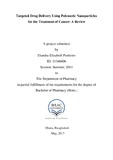| dc.contributor.advisor | Sheikh, Zara | |
| dc.contributor.author | Penheiro, Diandra Elizabeth | |
| dc.date.accessioned | 2019-01-30T07:17:51Z | |
| dc.date.available | 2019-01-30T07:17:51Z | |
| dc.date.copyright | 2017 | |
| dc.date.issued | 2017-05 | |
| dc.identifier.other | ID 11346006 | |
| dc.identifier.uri | http://hdl.handle.net/10361/11351 | |
| dc.description | This project report is submitted in partial fulfilment of the requirements for the degree of Bachelor of Pharmacy, 2017. | en_US |
| dc.description | Catalogued from PDF version of project report. | |
| dc.description | Includes bibliographical references (pages 26-38). | |
| dc.description.abstract | Advances in the field of polymeric nanoparticles is rapidly progressing and offers new opportunities for targeted treatment of cancer. The targeted delivery of nanoparticles can overcome the problems associated with the conventional cancer therapy such as lack of water solubility, nonspecific biodistribution and lack of selectivity resulting in non-specific toxicity towards normal cells and lower dose of drugs delivered to cancer cells leading to poor bioavailability and low therapeutic indices. Nanoparticles have shown great promise as drug-delivery vectors that are capable of preferentially targeting large doses of chemotherapeutic agents or therapeutic genes into malignant cells while leaving the healthy cells free. Nanoparticles that are used as drug delivery systems are submicron-sized particles (3-200nm) or colloidal systems of submicron size (<1μm) are constructed from a large variety of materials such as polymers (polymeric nanoparticles, micelles, dendrimers), lipids (liposomes) viruses (viral nanoparticles) as well as organo-metallic compounds. Various polymers are currently being explored to modify the properties of polymeric matrix which enables greater encapsulation efficiency and high therapeutic load with controlled release ability for the treatment of cancer. The present review explores the various types of polymeric nanoparticles and the different ways in which they have been utilized for the successful treatment of cancer. Passive targeting and ligand based targeting using nanoparticles have been discussed in details and the applications of different types of nanoparticles in the effective treatment of cancer has been exemplified. | en_US |
| dc.description.statementofresponsibility | Diandra Elizabeth Penheiro | |
| dc.format.extent | 38 pages | |
| dc.language.iso | en | en_US |
| dc.publisher | BRAC University | en_US |
| dc.rights | BRAC University project reports are protected by copyright. They may be viewed from this source for any purpose, but reproduction or distribution in any format is prohibited without written permission. | |
| dc.subject | Polymeric nanoparticles | en_US |
| dc.subject | Cancer | en_US |
| dc.subject.lcsh | Drug Delivery Systems--methods. | |
| dc.subject.lcsh | Polymeric composites. | |
| dc.subject.lcsh | Polymers. | |
| dc.title | Targeted drug delivery using polymeric nanoparticles for the treatment of cancer: a review | en_US |
| dc.type | Project report | en_US |
| dc.contributor.department | Department of Pharmacy, BRAC University | |
| dc.description.degree | B. Pharmacy | |
| dc.description.degree | B. Pharmacy | |

